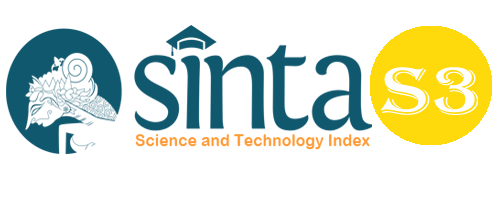Students' Perception on Collaboration through the Online Implementation of Interprofessional Education (IPE) in Handling Covid-19
Abstract
Interprofessional education is Interprofessional education (IPE) entails learning with, from, and about each other to enable effective collaboration and improve health outcomes. Negative perception, professional egoism, bad knowledge about it will hamper collaboration. Reducing negative perception and creating readiness is a prime target for IPE training. COVID-19 restrictions necessitated wholesale scale conversion of curricula to online learning environments globally. The research is aimed at getting students' perceptions of collaboration through interprofessional education online. This was a descriptive study. The study took place at Mahardika Health College. The respondents consisted of 155 students in nursing, public health, midwifery, and medical record students. Students were grouped into interprofessional teams for two days and participated in IPE training consisting of lectures and small group discussions. The training is done online using the zoom meeting app. At the beginning of the first session, they completed a pre-test survey with demographic items and measures of their perception of interprofessional education to work as a team. They completed a post-test with the same measures after the end of the session. 155 students completed both the pre-test and post-test survey. The student's perception before taking ipe training is 88.38 % good to be 100% good. This study demonstrated that a short series of IPE training experiences resulted in improved perceptions of interprofessional practice.
Keywords
Full Text:
PDFReferences
A Rhoda, N Laattoe, G., Smithdorf, N Roman, J Frantz. 2016. Facilitating Community-based Interprofessional Education and Collaborative Practice in A Health Sciences Faculty: Student Perceptions and Experiences. Afr J Health Professions EducAt eachuppl 2):225-228. DOI:10.7196/AJHPE.2016.v8i2.846
Achmad, BF.2011. The Relationship between Perceptions of Interprofessional Education and Attitudes for Cooperative Students at the Profession Stage of FK UGM. Essay. Universitas Gadjah Mada
Ateach, C., Snow, W., Wener, P., Macdonald, L., Metge, C., Davis, P., Fricke, M., Ludwig, S., Anderson, J. 2011. Nurse Education Today
Baker, C., Pulling, C., McGraw, R., Dagnone, JD, Hopkins-Rosseel, D., & Medves, J. 2008. Simulation in Interprofessional Education for Patient-Centered Collaborative Care. Journal of Advanced Nursing: 64(4); 372-379.
Coster S, Norman I, Murrells T, Kitchen S, Meerabeau E, Sooboodoo E, d'Avray L. Interprofessional attitudes amongst undergraduate students in the health professions: a longitudinal questionnaire survey. Int J Nurs Stud. 2008;45(11):1667-1681. DOI: 10.1016
Cusack, Tara, O'Donoghue, Grainne, 2012. The Introduction of an Interprofessional Education Module: Students'perception. Quality in Primary Care. 20:231-8
Fuadah, DZ 2014. Student Readiness to Learn Interprofessional Cooperation in Antenatal Care. Thesis. Gadjah Mada University.
Gough S., Hellaby M., Jones N., MacKinnon R. 2012. A review of undergraduate interprofessional simulation-based education (IPSE). Collegian . 19, 153—170
Gunaldo, TP, Andrieu, SC, Garbee, D., Giovingo, LK, Mercante, DE,
Tortu, S., and English, R. 2015. Student perceptions about interprofessional education after an elective course. Journal of Interprofessional Care. 29(4): 370–371. DOI: 10.3109/13561820.2014.969836.
Henderson, CD,et al.2013. Interprofessional education sessions involving doctor of pharmacy, bachelor of science in nursing, and nurse anesthetist students. Currents inPharmacyTeachingandLearning. 5(2013)458–469
Kingston R, Mari Kannan M, Suan Phaik K, Dinesh Kumar C, Ranjit De A, Hui Cing C et al. Suitability of the RIPLS and IEPS for Discriminating Attitude Differences towards Interprofessional Education among Students of Healthcare Profession. Educ Res Int. 2016. Article ID 5946154
Lee, R.,2009. Interprofessional Education: Principles and Application. Pharmacotherapy, 29(3):145e-164e.
Loversdge, Jacqueline, Demb, Ada. 2015. Faculty perceptions of key factors in interprofessional education. Journal of Interprofessional Care. 29(4): 298–304. DOI: 10.3109/13561820.2014.991912
MacDonald, MB, Bally, JM, Ferguson, LM, Murray, BL, Fowler-Kerry., & Anonson, JMS 2010. Nurse Education in Practice, 10: 238-242
Maharajan, MK, Kingston, Rajiah, Khoo, SP, Chellappan, KD, Alwis, RD, Hui, CC, , Lui LT, Yee, NT, Shin, YL, 2017. Attitudes and Readiness of Student of Healthcare Professions towards Interprofessional Learning. Pls One. DOI:10.1371/journal.pone.0168863
Me´ndez, MJ. P, MP,Armayor., NC, Navarlaz, MTD., Wakefield, A. 2007. The potential advantages and disadvantages of introducing interprofessional education into the healthcare curriculum in Spain. Nurses Education Today. 28, 327–336
Mu, K., Chao, CC, Jensen, GM, Royeen. Effect of Interprofessional Rural Training on Students'Perception of Interprofessional Health Care Services. Journal of Allied Health: 33.2:125
Ningrum, P. A., et al. (2020). The Potential of Poverty in the City of Palangka Raya: Study SMIs Affected Pandemic Covid 19. Budapest International Research and Critics Institute-Journal (BIRCI-Journal) Volume 3, No 3, Page: 1626-1634.
Noorharyanti, Reny. 2012. Student Perceptions of the Faculty of Medicine, Gadjah Mada University About Interprofessional Education (IPE) in the Implementation of IPE Activities. Essay. Gadjah Mada University.
Ogawara,et al. 2009. Systematic inclusion of mandatory interprofessional education in health professions curricula at Gunma University: a report of student self-assessment in a nine-year implementation. Human Resources for Health 7:60 doi:10.1186/1478-4491-7-60
Reeves S, Tassone M, Parker K, Simmons B. Interprofessional education: an overview of key developments in the past three decades. Work. 2012;41(3):233-45
Reeves, S. (2006). Delivering Practice-Based Interprofessional Education to Community Mental Health Teams: Understanding Some Key Lessons. Nurse Education In Practice (online series) accessed from http://elsevier.com.journal/nepr
Ruebling, Irma, Pole, David, Breitbach, AP, Frage, Alfred, Kettenbach, Ginge, Westhus, Nina, Kienstra Kathleen, Carlson, Judy, 2014. A Comparison of Student Attitudes and Perceptions Before and After an Introductory Interprofessional Education Experience. Journal of Interprofessional Care. DOI:10.3109/13561820.2013.82942.
Sihombing, E. H., Nasib. (2020). The Decision of Choosing Course in the Era of Covid 19 through the Telemarketing Program, Personal Selling and College Image. Budapest International Research and Critics Institute-Journal (BIRCI-Journal) Volume 3, No. 4, Page: 2843-2850.
Thistlethwaite, Jill, Nisbet, Gillian. 2007. Interprofessional Education: What's the Point and Where we're at..The Clinical Teacher..4: 67–72 67.
Walgito, B., 2007. Introduction to General Psychology. Andi Offset. Yogyakarta.
Woermann, U., Weltsch, L., Kunz, A., Stricker, D., Guttormsen, S., 2016. Attitude towards and Readiness for Interprofessional Education in Medical and Nursing Students of Bern. GMS Journal for Medical Education. Vol. 33(5), ISSN 2366-5017.
Andhini, C., Setyo, D., Rahayu, GR, Kamasturyani, Y., & Yusuf, H. (2021). The Effect of Interprofessional Education Training on Perception and Readiness of Health Students. 7(6), 1–6. https://aotmph.org/current-issue
Jones, TA, Vidal, G., & Taylor, C. (2020). Interprofessional education during the COVID-19 pandemic: finding the good in a bad situation. Journal of Interprofessional Care, 34(5), 633–646. https://doi.org/10.1080/13561820.2020.1801614
Khalili, H., & Xyrichis, A. (2020). A longitudinal survey on the impact of the COVID-19 pandemic on interprofessional education and collaborative practice: a study protocol. Journal of Interprofessional Care, 34(5), 691–693. https://doi.org/10.1080/13561820.2020.1798901
DOI: https://doi.org/10.33258/birci.v4i4.2677
Article Metrics
Abstract view : 162 timesPDF - 64 times
Refbacks
- There are currently no refbacks.

This work is licensed under a Creative Commons Attribution-ShareAlike 4.0 International License.

This work is licensed under a Creative Commons Attribution-ShareAlike 4.0 International License.

_.gif)

















_.gif)



